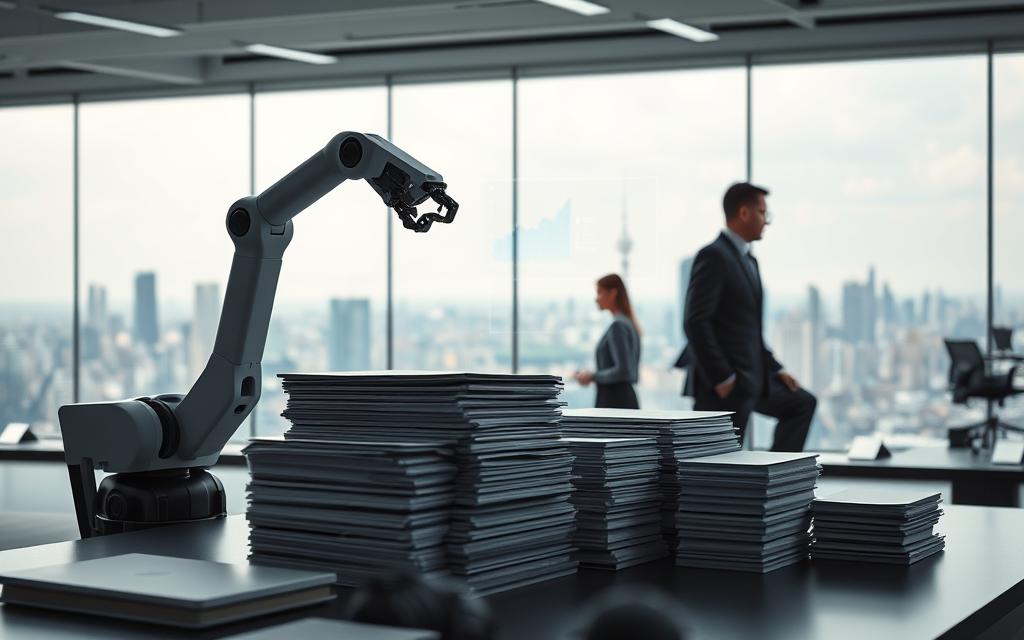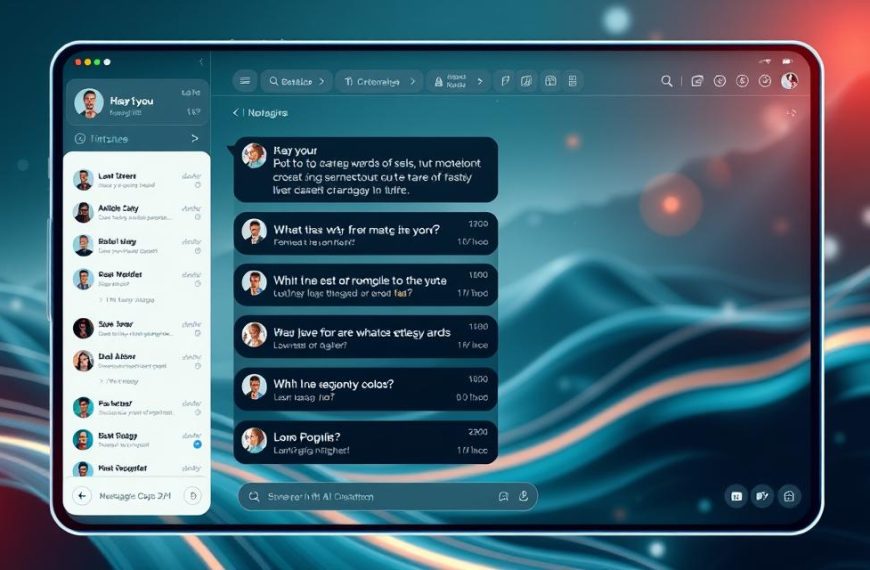Modern enterprises increasingly rely on intelligent solutions to streamline operations. Business process automation now integrates advanced technologies, reshaping workflows across industries. The market is projected to double, reaching $19.6 billion by 2026.
Unlike traditional systems, AI-driven tools adapt dynamically. They analyze unstructured data, make real-time decisions, and improve efficiency. Companies like Boomi deploy AI agents to automate complex tasks, from supply chains to customer service.
Industries such as healthcare and finance benefit significantly. Adaptive learning enables these tools to evolve with changing demands. This shift marks a new era in operational excellence.
Introduction to AI-Driven Business Automation
Cognitive technologies redefine efficiency in organizational tasks. Traditional process automation relied on rigid rules, but AI injects adaptability. Machine learning merges with workflow systems, enabling real-time adjustments.
Static chatbots pale against NLP-powered assistants. Microsoft’s Teams uses this technology to summarize meetings, while Cortana handles scheduling. These tools learn from interactions, improving accuracy over time.
Oxford Economics reports 70% of professionals believe automation fosters better roles. This shift reflects the rise of Intelligent Process Automation (IPA). IPA blends robotic tasks with AI-driven decision-making, optimizing outcomes.
The market for these solutions could hit $41.8 billion by 2033. Companies adopting IPA gain a competitive edge through scalable, data-centric workflows. This evolution marks a leap from manual oversight to autonomous intelligence.
How Is AI Impacting Business Process Automation?
Organizations witness a dual shift: task automation and career evolution.
33% of today’s occupations didn’t exist 25 years ago.
Intelligent tools replace repetitive work while spawning roles like AI trainers and data ethicists.
Boomi’s DesignGen agent exemplifies efficiency, cutting integration design time by 60%. The AI analyzes existing workflows, suggesting optimizations that once took hours. This accelerates digital transformation for enterprises.
In manufacturing, *predictive maintenance* slashes downtime by 45%. Sensors detect equipment anomalies before failures occur. Proactive fixes save millions in lost productivity.
Customer service also transforms. Telefonica’s NLP system handles 80% of routine inquiries without human agents. Processes like billing and troubleshooting now resolve in seconds.
The financial upside is staggering. Mayo Clinic projects $150B annual healthcare savings through automated diagnostics. Reduced errors and faster treatments redefine patient care.
As the AI agent market surges toward $28.5B by 2028, enterprises must adapt. Balancing efficiency gains with workforce development will shape the future of work.
Key Components of AI-Powered Automation
Five core technologies power today’s intelligent automation frameworks. Each plays a unique role in streamlining business process efficiency, from predictive analytics to real-time decision-making. Together, they reduce errors and accelerate workflows.
Machine Learning Algorithms
Machine learning enables adaptive demand forecasting. Amazon’s implementation cut inventory errors by 35% and stockouts by 28%. Algorithms analyze historical sales data, adjusting predictions for seasonal trends.
Natural Language Processing (NLP)
Natural language processing automates document handling. Microsoft’s Office 365 saves 15,000 hours yearly by extracting contract terms and generating summaries. NLP also powers multilingual customer support chatbots.
Robotic Process Automation (RPA)
Robotic process automation handles repetitive tasks flawlessly. AT&T’s software bots process invoices 60% faster, resolving 90% of billing inquiries autonomously. RPA integrates with legacy systems without costly upgrades.
Computer Vision and IoT Integration
DHL’s warehouses use computer vision to sort packages with 99.8% accuracy. IoT sensors track inventory in real time, reducing manual scans. This combo is vital for logistics and quality control.
Big Data Analytics and Cloud Computing
Boomi’s cloud platform syncs data across 500+ endpoints instantly. Analytics identify bottlenecks in supply chains, enabling proactive fixes. Cloud-based tools scale effortlessly with business growth.
| Component | Function | Example |
|---|---|---|
| Machine Learning | Predictive modeling | Amazon’s inventory system |
| NLP | Text/document analysis | Microsoft Office 365 |
| RPA | Task automation | AT&T’s billing bots |
| Computer Vision | Image/object recognition | DHL’s warehouse sorting |
| Cloud Computing | Real-time data sync | Boomi’s integration platform |
These technologies create a cohesive automation ecosystem. They eliminate silos, turning fragmented systems into unified workflows. The result? Faster operations and higher accuracy across industries.
Top Benefits of AI in Business Process Automation
Data-driven tools unlock unprecedented operational benefits. Companies leveraging intelligent automation report efficiency gains, cost savings, and sharper decisions. From marketing to logistics, these advantages redefine competitive standards.
Enhanced Efficiency and Productivity
Coca-Cola’s AI-powered marketing boosted conversions by 40%. Automation handles repetitive tasks, freeing teams for strategic work. Microsoft’s Teams tools save employees 7 hours weekly, elevating product output.
Cost Reduction and Resource Optimization
Unilever slashed hiring costs by 50% using AI recruitment. KPMG’s IBM Watson integration cut audit time by 65%. These savings redirect funds toward innovation and growth.
Improved Decision-Making with Data Insights
Netflix’s recommendation engine drives 80% of viewer choices. ANN algorithms analyze behavior patterns, enabling hyper-personalized content. Real-time analytics transform gut calls into data-backed decisions.
Scalability and 24/7 Operations
Boomi’s real-time integrations monitor supply chains nonstop. DHL’s route optimization handles 200% volume spikes without extra staff. Efficiency scales seamlessly, ensuring uninterrupted operations.
AI-Powered Automation vs. Traditional Methods
Legacy tools struggle to match the precision and adaptability of modern AI-driven solutions. Traditional OCR systems achieve only 60% accuracy with document variations, while AI-powered processing exceeds 95%. This gap highlights the limitations of rule-based technologies.
Boomi’s intelligent mapping slashes integration errors by 75% compared to manual methods. Over three years, AI solutions deliver 300% ROI, outperforming traditional automation. Static workflows lack the dynamic adjustments AI enables.
- Adaptive Capacity: Boomi GPT’s multi-agent collaboration learns from data, unlike scripted bots.
- Cost Efficiency: AI reduces operational expenses by optimizing business processes in real time.
- Case Study: A financial institution cut fraud false positives by 90% using AI instead of rules-based systems.
Oxford Economics reports that 33% of today’s jobs didn’t exist 25 years ago, reflecting AI’s transformative role. Enterprises leveraging intelligent tools gain agility and accuracy, as seen in AI-driven business process automation.
AI’s real-time decision-making eclipses outdated methods. The global automation market, projected to hit $41.8 billion by 2033, underscores this shift. Companies adopting these technologies future-proof their operations.
Real-World Applications Across Industries
From finance to healthcare, intelligent automation reshapes industry standards with measurable results. Enterprises leverage advanced solutions to tackle sector-specific challenges, achieving efficiency gains of 40–60%. These implementations redefine what’s possible in operational excellence.
Customer Service: NLP-Powered Chatbots
Telefonica’s Amelia chatbot resolves 85% of inquiries autonomously. Customer service teams saw resolution rates jump from 62% to 89% with 24/7 availability. Natural language processing understands complex queries, reducing wait times by 70%.
Manufacturing: Predictive Maintenance
Siemens’ AI-driven sensors cut unplanned downtime by 73%. Real-time monitoring detects equipment anomalies before failures occur. This proactive approach optimizes the production process, saving millions annually.
Finance: Fraud Detection and Risk Management
PayPal’s algorithms prevent over $2B in fraudulent transactions yearly. Machine learning analyzes patterns across 4B+ data points, flagging risks instantly. These solutions reduce false positives by 90% compared to rule-based systems.
Healthcare: Diagnostic Automation
Mayo Clinic’s AI tools slash diagnostic errors by 45%. PathAI matches senior pathologists in cancer detection accuracy.
“Automated diagnostics enable faster treatments, saving $150B industry-wide,”
notes a clinic spokesperson.
Cross-industry adoption proves intelligent tools deliver consistent value. Whether streamlining customer service or refining medical diagnoses, these algorithms set new benchmarks. The future belongs to businesses embracing such transformative solutions.
AI in Supply Chain and Logistics
Global supply chains gain unprecedented agility through AI-driven logistics. Intelligent tools optimize business operations, slashing costs and delays. DHL’s route algorithms cut fuel expenses by 15%, proving the power of predictive analytics.
Amazon’s inventory management reduces stockouts by 35%. Machine learning analyzes purchasing trends, adjusting stock levels dynamically. This precision ensures shelves stay full without overstocking.
Maersk’s container tracking boosts delivery accuracy to 98%. Real-time data from IoT sensors reroutes shipments around disruptions. Such systems turn chaotic logistics into clockwork.
- UPS ORION: Saves 10M gallons of fuel yearly via AI-optimized routes.
- Walmart’s Analytics: Prevents $1B+ in waste by predicting demand spikes.
- Blockchain Integration: Cuts supplier onboarding by 70% with automated verification.
| Company | Solution | Impact |
|---|---|---|
| DHL | AI Routing | 15% fuel savings |
| Amazon | Inventory AI | 35% fewer stockouts |
| Maersk | Container Tracking | 98% ETA accuracy |
| Walmart | Predictive Analytics | $1B+ waste prevented |
Boomi’s IoT platform syncs 500+ warehouses instantly. Live data feeds prevent product shortages, ensuring seamless business operations. These innovations redefine what’s possible in supply chain management.
“AI turns logistics into a strategic asset, not just a cost center,” notes a DHL executive.
The future hinges on blending AI with human expertise. As tools evolve, so will the speed and resilience of global trade networks.
Transforming HR and Recruitment with AI
Human resources departments are undergoing a digital revolution. Intelligent tools now handle critical tasks, from screening resumes to predicting employee retention. This shift allows HR teams to focus on strategic initiatives while maintaining compliance.
Automated Resume Screening
Unilever reduced hiring time by 75% using AI-powered screening. Their system analyzes thousands of applications in minutes, identifying top candidates objectively. Pymetrics’ neural networks cut hiring bias by 60% in Fortune 500 companies, promoting diversity.
These tools evaluate skills beyond keywords. They assess problem-solving abilities through gamified tests. The result? Better-matched employees and reduced turnover.
Employee Onboarding and Engagement
SAP SuccessFactors creates personalized onboarding paths with AI. New hires complete tasks 35% faster, boosting retention. The system adapts to individual learning styles, ensuring smoother transitions.
IBM Watson predicts attrition risks with 85% accuracy. By analyzing sentiment in feedback and emails, it flags disengagement early. Managers receive alerts to address concerns proactively.
- Compliance: Workday’s AI audit trails reduced HR violations by 90%
- Skills Mapping: Eightfold.ai closes skills gaps three times faster
- Service: Chatbots handle 70% of routine HR queries instantly
“AI transforms HR from paperwork to people-work,” notes a Unilever executive.
These innovations streamline processes while humanizing the employee experience. As tools evolve, they’ll further redefine talent management.
Challenges in Implementing AI Automation
Adopting intelligent automation brings transformative benefits, but organizations face significant hurdles. Legacy infrastructure, data risks, and workforce readiness often stall progress. Addressing these barriers ensures smooth transitions and maximizes ROI.
Integration with Legacy Systems
40% of enterprises report outdated systems as their biggest obstacle. Bank of America spent 18 months merging ERP platforms with AI tools. Technical debt consumes 30% of project budgets for compatibility fixes.
Modern technologies struggle with archaic databases and protocols. Custom APIs and middleware become essential but costly. Without proper integration, automation delivers fragmented results.
Data Privacy and Security Concerns
GDPR fines surged 40% year-over-year due to AI compliance failures. One healthcare provider faced a $2.3M penalty for exposed training data. Sensitive information requires robust encryption and access controls.
- Regulatory Risks: AI models must align with HIPAA, CCPA, and industry-specific mandates
- Third-Party Vulnerabilities: 63% of breaches originate in vendor ecosystems
- Audit Trails: Automated logging proves compliance during regulatory reviews
Workforce Adaptation and Training
AT&T invested $1B to reskill 50,000 employees for AI-augmented roles. Resistance drops 65% when companies use structured playbooks like Siemens’. Continuous learning programs bridge skill gaps effectively.
Key strategies include:
- Interactive workshops demonstrating AI-assisted processes
- Mentorship pairing junior staff with automation specialists
- Gamified training modules boosting engagement by 40%
“Change management determines whether AI initiatives sink or swim,” notes a Deloitte automation lead.
Successful implementations balance technological potential with human factors. Proactive planning turns these challenges into competitive advantages.
Solutions for Successful AI Adoption
Three critical pillars support effective implementation of cognitive technologies. Strategic partnerships, robust data frameworks, and workforce development transform potential into results. Companies mastering these areas see 3x faster ROI according to McKinsey research.
Choosing the Right Technology Partners
Boeing’s collaboration with SparkCognition cut aircraft maintenance costs by 25%. Their AI predicts component failures 200+ hours before issues occur. This showcases the value of specialized partnerships.
Boomi’s pre-built connectors demonstrate partner advantages. Enterprises reduce integration time by 80% compared to custom development. Key selection criteria include:
- API availability for legacy system compatibility
- Compliance certifications (SOC2, ISO 27001)
- Proven industry use cases
| Evaluation Factor | Weight | Top Performer |
|---|---|---|
| Implementation Speed | 30% | Boomi (80% faster) |
| Security Standards | 25% | IBM Cloud (200+ certs) |
| Scalability | 20% | Amazon SageMaker |
| Cost Efficiency | 25% | Microsoft Azure |
Prioritizing Data Governance
Mastercard’s AI ethics framework achieves 100% regulatory compliance. Their system auto-detects bias in credit algorithms, adjusting approvals fairly. Such management prevents costly violations.
Pfizer’s phased rollout offers another best practice. Starting with non-critical data, they achieved 90% user adoption in six months. This staged approach builds trust while testing controls.
Upskilling Employees for AI Collaboration
Amazon’s Machine Learning University graduated 10,000+ certified employees last year. Their six-week bootcamps cover practical applications, not just theory. 92% of successful implementations involve such structured programs.
AT&T’s reskilling initiative shows measurable impact. Technicians trained on predictive maintenance tools resolve issues 40% faster. Continuous learning turns workforce anxiety into engagement.
These solutions create sustainable adoption pathways. From vendor selection to daily operations, they bridge the gap between potential and performance. The result? Organizations that evolve with technology rather than chase it.
Future Trends in AI and Business Automation
The next wave of innovation will redefine enterprise operations. Gartner forecasts 80% of companies will adopt AI-enhanced tools by 2026. Autonomous agents could manage nearly half of all workflows by 2030, signaling a seismic shift in corporate strategy.
Self-optimizing supply chains represent one groundbreaking development. These systems automatically reroute shipments, adjust inventory, and prevent disruptions—all without human input. Walmart’s experimental network already reduces waste by 15% through real-time adjustments.
No-code platforms are democratizing automation. Tools like Appian allow employees with minimal technical skills to create custom workflows. This trend could empower 90% of staff to build solutions tailored to their daily needs.
- Negotiation Bots: IBM’s Project Debater handles complex contract discussions with 85% accuracy
- Quantum Leap: D-Wave’s processors solve routing problems in seconds versus hours
- Transparency Standards: New ISO guidelines ensure explainable decision-making in finance and healthcare
| Trend | Impact | Early Adopters |
|---|---|---|
| Autonomous Systems | 40% lower operational costs | Maersk, DHL |
| No-Code Platforms | 5x faster workflow creation | Salesforce, Zapier |
| Quantum AI | 1000x speed boost | Volvo, Airbus |
| Ethical Frameworks | 90% compliance rates | JPMorgan, Mayo Clinic |
Ethical considerations are gaining prominence. The EU’s proposed AI Act mandates strict documentation for automated decisions. Companies like Siemens now audit algorithms monthly to ensure fairness in hiring and lending.
“We’re entering an era where machines don’t just execute tasks—they strategize,” notes a McKinsey automation lead.
These advancements promise unprecedented efficiency. Yet they require careful implementation to balance innovation with responsibility. The organizations mastering this equilibrium will lead their industries.
Conclusion
Enterprise leaders now recognize automation as a competitive necessity. Documented use cases show 40–60% efficiency gains, with 87% of CXOs reporting stronger market positioning. The average ROI reaches 3.5x within two years.
Adoption is no longer optional—73% of industry leaders mandate AI-first strategies. Start with a clear roadmap:
- Audit existing workflows
- Prioritize high-impact processes
- Select scalable technologies
- Train teams for collaboration
- Measure and iterate
By 2035, intelligent tools will influence 95% of business process automation. Companies like Boomi lead this transformation, offering proven integration solutions. The future belongs to those who act now.



















